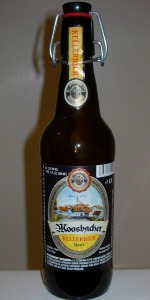
Back in December, we had our Winter Tasting and one the selected beers was Mendocino's Imperial IPA. This beer was not amongst my favorites, being very astringent and unbalanced in this reviewers opinion. Since no one bought the extra 2 bottles (apparently the other participants agreed with me), I resolved to age them to what would become of the flavor. After 7 months of aging and a week of refrigeration, it was time to review.
This Imperial IPA comes in a decorative bottle and is only available in winter as their seasonal offering. It is listed as 9% ABV, and this bottle was a 2005/6 vintage.
The appearance is a lovely gold-orange hue, but cloudy, nominal indications of carbonation, topped off by a sufficient brownish-white head.
A rather vague, sweetish malt aroma lingers in the back of the nose, while a big floral hoppiness dominates aroma. The smell comes across as a big beer, balanced in favor of late hopping.
Mouthfeel is a medium-full thickness, smooth and almost creamy. Definitely a big beer.
The taste had significantly changed, as the astringent hop flavor was much subdued, though it definitely rules the overall flavor. The malt is evident, not so much in flavor, but more in a thick mouthfeel, making this beer still somewhat unbalanced. It is definitely a "big" beer, but many of the I2PA's I've had, tend to juggle a large hop character with a underlying sweet malt, which makes the beer all the more drinkable, even at 9% ABV. A good example of this is Rogue's I2PA. One interesting characteristic was that the ABV was not manifest in either an alcohol "slickness", nor even in effect. Usually I can tell when I've drank a high gravity beer, but this one's impact was minimal.
Overall, the aging process made the Mendocino much more drinkable, but still not balanced enough. And since this is my blog, I'll go on record as saying that too many American brewers are trying to make the "big beer", but end up making something that is not representative of the style, nor is it enjoyable as a 12oz experience. Ultimately, with human limitations in mind, drinking beer is about enjoyment and refreshment. While the experience of individual beers and drinkers ends up being a largely subjective experience, the BJCP standards exist for a purpose and "beer without rules" may be fun to experiment with, but often fall short of enjoyment.
There is one more Mendocino which I plan to consume in December, so we'll see what one year does.
Labels: beer reviews

